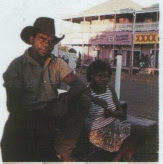ABORIGINAL
AUSTRALIANS
THE ABORIGINALS
settled the Australian continent more than 40,000 years ago. They lived in
total isolation from the rest of the world, existing by hunting and
gathering. In the 18th century, the Europeans arrived, forcing the
Aboriginals off their territories. Today, many feel isolated from white
society, but still try to preserve their tribal identity.
|
ชาวออสเตรเลียดั้งเดิม
ชาวอะบอริจินได้ตั้งรกรากบนทวีปออสเตรเลียมากกว่า
40,000 ปีแล้ว อาศัยอยู่โดดเดียวแยกต่างหากจากชาวโลกอื่นๆ โดยเป็นนักล่าสัตว์และเก็บของป่า
( hunter-gatherer)
ในศตวรรษที่ 18 ชาวยุโรปเดินทางไปถึง
บังคับให้ชาวอะบอริจินออกจากดินแดนของพวกเขา ปัจจุบันชาวอะบอริจินจำนวนมากแยกตัวออกจากสังคมสีขาว
(white
society) แต่ก็ยังพยายามสงวนอัตลักษณ์ของเผ่าพันธุ์ตัวเองไว้
|
||
Ways of life
Traditionally,
Aboriginals lived by hunting and gathering. They were nomadic, roaming over
large stretches of territory, setting up temporary camps near watering
places, and moving on when food supplies were exhausted. They traded with
other tribes, exchanging goods such as spears.
|
วิถีชีวิต
ชาวอะบอริจินดั้งเดิมอาศัยเลี้ยงชีพโดยการล่าสัตว์และหาของป่า
พวกเขาจะเที่ยวเร่ร่อนไปทั่วดินแดนอันกว้างใหญ่ ตั้งค่ายพักแรมชั่วคราวใกล้กับแหล่งน้ำ
และย้ายไปเมื่ออาหารหมด พร้อมทั้งทำการค้าขายกับชนเผ่าอื่น ๆ
ด้วยการแลกเปลี่ยนสินค้าต่าง ๆ เช่น หอก
|
Aboriginal history
Aboriginals first
reached Australia during the last Ice Age. Sea levels were low, and they were
able to cross from Southeast Asia over land bridges and small stretches of
water. When the ice melted and sea levels rose again, the continent was
completely cut off. Initially, the settlers clung to the coasts and rivers,
but gradually moved across the continent. By the time Europeans arrived,
there were about 500 different tribal groups living in Australia.
|
ประวัติศาสตร์ชาวอะบอริจิน
ชาวอะบอริจินเดินทางมาถึงออสเตรเลียครั้งแรก
ในยุคน้ำแข็งตอนปลาย (the
last Ice Age) ระดับน้ำทะเลยังต่ำ
และพวกเขาก็สามารถจะเดินทางข้ามไปยังเอเชียตะวันออกเฉียงใต้ผ่านสะพานแผ่นดินข้ามทวีปและการขยายตัวของน้ำเล็กน้อย
เมื่อน้ำแข็งหลอมเหลวและระดับน้ำทะเลสูงขึ้นอีกครั้ง
ทวีปจึงแยกออกจากกันโดยสิ้นเชิง เริ่มแรก
เหล่าชนผู้ตั้งถิ่นฐานยังยึดติดอยู่กับชายฝั่งทะเลและแม่น้ำ แต่ต่อมาก็ค่อย ๆ
ย้ายข้ามทวีป ในยุคที่ชาวยุโรปเดินทางมาถึง
มีกลุ่มชนเผ่าอาศัยอยู่ในทวีปออสเตรเลียประมาณ 500 กลุ่ม
|
Hunting and
gathering
Aboriginals lived
by hunting animals such as kangaroos, and supplemented their diet with wild plants,
nuts, and berries. The hunters used spears with stone blades and wooden
boomerangs, a type of missile that flies back to the thrower. Some tribes
developed an elaborate sign language, so that they could send silent messages
to each other when they were stalking game.
|
การล่าสัตว์และการหาของป่า
ชาวอะบอริจินเลี้ยงชีวิตด้วยการล่าสัตว์
เช่น จิงโจ้ และหาอาหารป่าเพิ่มเติม เช่น พืชจำพวกถั่วและผลเบอร์รี่
นักล่าจะใช้หอกมีคมเป็นหินและบูมเมอแรงทำด้วยไม้
ซึ่งเป็นอาวุธที่ขว้างออกไปแล้วย้อนกลับมาหาผู้ขว้าง ชนเผ่าบางเผ่าก็พัฒนาภาษาสัญลักษณ์อันซับซ้อน
เพื่อที่พวกเขาจะได้ส่งข้อความใบ้ไปหากันในขณะที่กำลังล่าสัตว์
|
Corroborees
Aboriginal peoples
have handed down stories, songs, and traditions from generation to
generation. This culture is kept alive at corroborees, ceremonial dances
where tribes gather together to retell the tales of Australia's past through
songs, music, and dance.
|
พิธีเคอะร็อบเบอะรี
ชาวอะบอริจินได้ทิ้งเรื่องราว เพลงและวัฒนธรรมจากยุคหนึ่งไปสู่ยุคหนึ่ง วัฒนธรรมนี้ได้เก็บรักษาไว้ในพิธีเคอะร็อบเบอะรี
(corroborees) ซึ่งเป็นพิธีการเต้นรำในเวลาที่ชนเผ่ามารวมกันเพื่อเล่าเรื่องราวเก่า
ๆ ในอดีตของออสเตรเลียผ่านทางเพลง ดนตรี และการเต้นรำ
|
Aboriginal hunters used silent signals
to avoid disturbing the game. The sign for kangaroo starts with a closed hand
and moves to an open shape.
|
นักล่าชาวอะบอริจินจะใช้สัญลักษณ์ใบ้เพื่อหลีกเลี่ยงการรบกวนการล่าสัตว์
สัญลักษณ์ใช้สำหรับจิงโจเริ่มด้วยการหุบมือและขยายออก
|
||
Dreamtime
The Aboriginals
believe that Dreamtime is a period when Ancestral Beings shaped the land,
creating all species and human beings. These beings are thought to live on
eternally in spirit form. Human beings are believed to be a part of nature,
closely associated with all other living things. Images of spirits of
Dreamtime, such as Lightning Man, cover sacred cliffs and caves in tribal
areas.
|
ยุคความฝัน
ชาวอะบอริจินมีความเชื่อว่า
ยุคความฝันเป็นยุคที่บรรพบุรุษก่อตั้งดินแดน สร้างเผ่าพันธุ์มนุษย์ทั้งหมด สิ่งมีชีวิตเหล่านี้มีความเชื่อว่ามีชีวิตนิรันดร์ในโลกแห่งวิญญาณ
มนุษย์ทั้งหลายเชื่อกันว่าเป็นส่วนหนึ่งของธรรมชาติ
มีความสัมพันธ์ใกล้ชิดกับสิ่งมีชีวิตอื่น ๆ ทั้งหมด ภาพวาดวิญญาณแห่งยุคความฝัน เช่น
“ชนสายฟ้า” (Lightning Man) ซึ่งมีอยู่ทั่วไปบนหน้าผาและถ้ำอันศักดิ์สิทธิ์ในบริเวณดั้งเดิม
|
||
Uluru (Ayers Rock)
Aboriginals
believe that the Ancestral Beings created the Australian landscape, and
established customs and traditions still followed today. They have left evidence
of their presence in the many sacred places, such as Uluru in central
Australia. This is revered as a sacred place by the local Aranda people. Once
called Ayers Rock by the Australian government, the rock regained its
Aboriginal name in 1988.
|
โขดหินอุลูรู (Uluru) หรือ "หินแอร์ส"(Ayers
Rock)
ชาวอะบอริจินเชื่อว่าเทพเจ้าได้สร้างภูมิประเทศแห่งออสเตรเลียและสร้างวัฒนธรรมที่พวกเขานับถือมาจนถึงปัจจุบัน
เทพเจ้าได้ทิ้งหลักฐานไว้มากมาย เช่น โขดหินอูลูรูในตอนกลางของออสเตรเลีย
โขดหินนี้ชาว Aranda (Arrernte, Arunta, หรือ Arrarnta)
ชนเผ่าท้องถิ่นถือกันว่าเป็นสถานที่ศักดิ์สิทธิ์
แต่ก่อนรัฐบาลออสเตรเลียเรียกว่า หินแอร์ส (Ayers Rock) ในปี ค.ศ. 1988 (พ.ศ. 2531) จึงตั้งชื่อคืนเป็นภาษาอะบอริจิน
|
Aboriginals today
European colonists
arrived in Australia in 1788, and displaced Aboriginal tribes from their
territory. Today, there are about 250,000 Aboriginals in
Australia, many of
whom live in urban areas. Although there is still discrimination, Aboriginals
are beginning to benefit from government aid, and to assert their civil
rights.
|
ชาวอะบอริจินในปัจจุบัน
นักล่าอาณานิคมชาวยุโรปได้เดินทางมาถึงออสเตรเลียในปี
ค.ศ. 1788 (พ.ศ. 2331) และบังคับให้ชนเผ่าอะบอริจินออกไปจากดินแดนของพวกเขา ปัจจุบัน
(พ.ศ. 2540) มีชาวอะบอริจินในประเทศออสเตรเลียประมาณ 250,000 คน ซึ่งมีจำนวนมากที่อาศัยอยู่ในเมือง
แม้ว่าจะยังคงมีการเลือกปฏิบัติอยู่
ชาวอะบอริจินก็เริ่มจะได้รับผลประโยชน์จากรัฐบาลและมีสิทธิ์เป็นพลเมืองของออสเตรเลีย
|
Land rights
When the Europeans
arrived in Australia they claimed that the land was Terra nullius, that
it belonged to no one, and that they were entitled to occupy it. More recently,
the Aboriginals have campaigned to regain their lost territory and sacred
sites. In 1993, the Australian government reversed its Terra nullius policy.
|
สิทธิในที่ดิน
เมื่อชาวยุโรปเดินทางมาถึงออสเตรเลีย
พวกเขาก็อ้างว่า แผ่นดินแดนนั้น เป็นดินแดนที่ไม่มีเจ้าของ
(Terra
nullius) ซึ่งไม่มีใครเป็นเจ้าของและอ้างว่าพวกเป็นผู้ใช้สิทธิยึดครองดินแดนแห่งนั้น
เมื่อเร็ว ๆ นี้
ชาวอะบอริจินก็ได้มีการรณรงค์เพื่อเรียกคืนดินแดนที่สูญเสียไปและสถานที่อันศักดิ์กลับคืนมา
ในปี ค.ศ. 1993 (พ.ศ. 2536) รัฐบาลออสเตรเลียก็เพิกถอนนโยบาย Terra nullius
|
Education
During early
contact with the Europeans, Aboriginal languages were lost or fell into
disuse. In 1972, the government established a bilingual education programme. Many
children are now taught in their tribal languages before learning English.
Books, radio, and television broadcasts are all available in many Aboriginal
languages.
|
การศึกษา
ในระหว่างการติดต่อกับชาวยุโรปยุคแรก
ภาษาอะบอริจินได้สูญหายไปหรือไม่มีการใช้ ใน ค.ศ. 1972 (พ.ศ. 2515)
รัฐบาลได้ก่อตั้งโครงการการศึกษาสองภาษา ปัจจุบัน เด็ก ๆ
มากมายจึงได้รับการสอนภาษาดั้งเดิมของพวกเขาก่อนที่เรียนภาษาอังกฤษ หนังสือ
วิทยุ และการถ่ายทอดทางโทรทัศน์ ก็มีอยู่ทั่วไปในภาษาอะบอริจิน มากมาย
|
Life in Early
Australia
European explorers
located Australia long after they had begun colonizing other lands. Dutch
explorers were probably the first Europeans to reach Australia around 1605. Australia
was not claimed by a European power, however, until the British did so in
1770. Early Australia had many groups of people with diverse interests, including
a native population that had lived on the island for at least 40,000 years.
|
การดำเนินชีวิตในออสเตรเลียยุคแรก
นักสำรวจชาวยุโรปได้ค้นหาแหล่งที่ตั้งของออสเตรเลียอยู่นานหลังจากพวกเขาเริ่มบุกเบิกอาณานิคมในดินแดนอื่น
ๆ บางที่อาจจะเป็นนักสำรวจชาวดัทช์ที่เป็นชาวยุโรปพวกแรกที่เดินทางไปถึงออสเตรเลียประมาณ
ค.ศ. 1605 (พ.ศ. 2148) อย่างไรก็ตาม
ออสเตรเลียไม่ถูกอ้างกรรมสิทธิ์จากอำนาจของชาวยุโรป
จนกระทั่งชาวอังกฤษได้ทำการอ้างกรรมสิทธิ์ ในปี ค.ศ. 1770 (พ.ศ. 2313) ออสเตรเลียในยุคแรกมีกลุ่มคนมากมายที่ให้ความสนใจหลากหลาย
รวมทั้งประชากรท้องถิ่นซึ่งอาศัยอยู่บนเกาะมาเป็นเวลาอย่างน้อย 40,000 ปี
|
||
Original
Australians
Aboriginal society
developed in close harmony with nature. There were between 200 and 300
Aboriginal languages, and most people were bilingual or multilingual. By
1900, half of Australia’s original inhabitants had died fighting the British
or from disease. The engraving below depicts an Aboriginal man with
ceremonial face paint and scars. The other image below is an ancient
Aboriginal rock painting.
|
ชาวออสเตรเลียดั้งเดิม
สังคมอะบอริจินได้วิวัฒนาการด้วยความเป็นอันหนึ่งอันเดียวกันกับธรรมชาติ
มีภาษาอะบอริจินอยู่ระหว่าง 200 – 300 ภาษา
และผู้คนส่วนมากพูดได้สองภาษาและหลายภาษา เมื่อ ค.ศ. 1900 (พ.ศ. 2443)
คนพื้นเมืองชาวอะบอริจินของออสเตรเลียครึ่งหนึ่ง
ได้เสียชีวิตลงจากการต่อสู้กับชาวอังกฤษหรือโรคภัยไข้เจ็บ ภาพแกะสลักด้านล่าง อธิบายถึงผู้ชายชาวอะบอริจินมีใบหน้าแต้มสีหรือแผลเป็นจากพิธีกรรม
ภาพด้านล่างอีกอันหนึ่ง คือภาพวาดบนหินของชาวอะบอริจินโบราณ
|
Convicts
Beginning in 1788,
England sent both male and female prisoners to Australia—sometimes with their
children. Convicts built public buildings, roads, and bridges. England
stopped sending convicts to Australia in 1868. The prison ship shown here
housed prisoners before they went to Australia.
|
นักโทษ
เริ่มต้นใน ค.ศ. 1788 (พ.ศ.
2331) อังกฤษได้ส่งนักโทษทั้งชายหญิงไปยังออสเตรเลีย บางครั้งก็มีเด็กด้วย เหล่านักโทษได้สร้างตึกรามบ้านช่อง
ถนนและสะพานสาธารณะมากมาย อังกฤษได้หยุดส่งนักโทษไปยังออสเตรเลียในปี ค.ศ. 1868
(พ.ศ. 2411) เรือสำเภาส่งนักโทษในภาพเป็นที่พักอาศัยของเหล่านักโทษก่อนที่พวกเขาจะถูกส่งไปยังออสเตรเลีย
|
Gold Miners
In 1851, lured by
the potential of striking it rich, thousands of people began prospecting for
gold in Australia. Sometimes whole families moved to the gold fields, but
life in the gold camps was hard and very few people struck it rich. Searching
for gold was hard and dirty work, as this painting illustrates.
|
เหมืองทอง
ในปี ค.ศ. 1851 (พ.ศ. 2394) ผู้คนหลายพันคนถูกอำนาจแห่งความร่ำรวยดึงดูดใจจึงเริ่มออกค้นหารทองในออสเตรเลีย
บางครั้ง ทั้งครอบครัวจะอพยพไปทุ่งทองคำ แต่การใช้ชีวิตในแคมป์ทองคำยากลำบากและมีผู้คนเพียงเล็กน้อยที่ร่ำรวย
การค้นหาทองคำยากลำบากและเป็นงานที่เปรอะเปื้อน ดังภาพวาดด้านล่างนี้
|
||
|
|
|||
Australian
Aboriginal Cave Painting
This
Aboriginal cave painting is in Kakadu National Park, Australia. Aboriginal
people have lived in this area for at least 25,000 years. The painting
depicts a Barramundi fish and a Dreamtime spirit. In the Aboriginal culture,
Dreamtime is a supernatural past in which ancestral beings shaped and
humanized the natural world.
|
ภาพวาดผนังถ้ำของชาวอะบอริจินในออสเตรเลีย
ภาพวาดของชาวอะบอริจินนี้อยู่ในอุทยานแห่งชาติคาคาดุ
(Kakadu National Park) ประเทศออสเตรเลีย
ชาวอะบอริจินอาศัยอยู่บริเวณนี้เป็นเวลาอย่างน้อย 25,000 ปี ภาพวาดนี้พรรณนาถึงปลาตะเพียนขาวและวิญญาณบรรพบุรุษยุคความฝัน
ในวัฒนธรรมของชาวอะบอริจิน ยุคความฝันเป็นอดีตที่เหนือธรรมชาติซึ่งบรรพบุรุษก่อตัวขึ้นและได้สร้างโลกธรรมชาติให้เป็นของมนุษย์
|
||

















